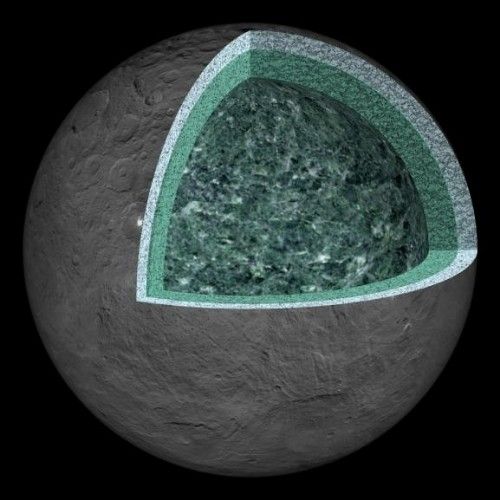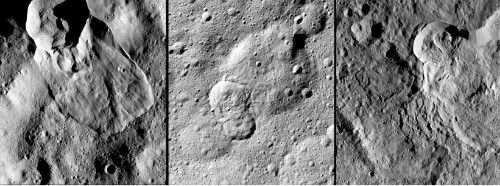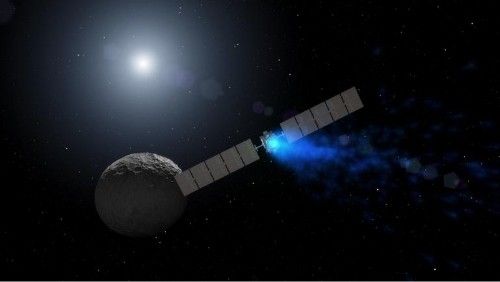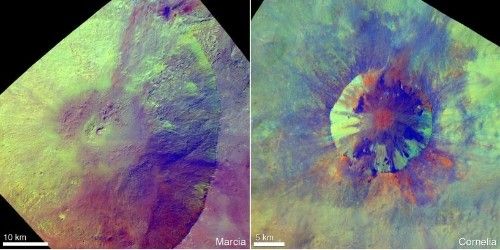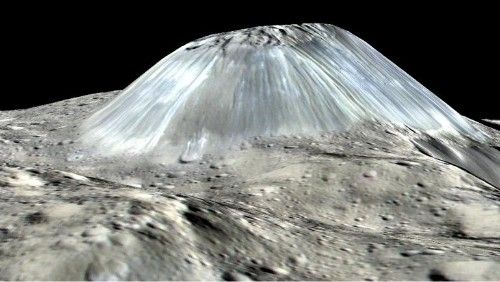What We Learned from Dawn
NASA’s Dawn mission, which launched in 2007, sought to characterize the processes that dominated early solar system evolution. To build a detailed picture of those early days, Dawn visited two time capsules of the solar system—Vesta and Ceres, the largest bodies of the main asteroid belt. Studying these planet-like worlds, intact survivors from the earliest part of solar system history, gave scientists insight into the original building blocks of the solar system. And by mapping the bodies from orbit, the spacecraft was able to provide key pieces of data that scientists couldn’t get using telescopes or brief flybys.
What did we learn from Dawn during its groundbreaking, 11-year mission?
Dawn showed us that location was key to how the early system organized and evolved.
Dawn highlighted how important place of birth was for bodies in the early days of our solar system, which formed 4.6 billion years ago.
Understanding the environment where the smaller planets formed is crucial to understanding their destiny, Dawn showed us. Early solar system and planetary migration models now must account for the findings Dawn has made over the last seven years.
Vesta, which likely formed in the inner solar system and stayed there, evolved in many ways like the rocky planets of the inner solar system. Dawn’s mapping of Vesta’s craters revealed that the northern hemisphere of Vesta is an ancient surface that had more large impacts than expected based on pre-Dawn models of asteroids in the main belt. This suggests that there were more large objects early on and tells us that “planetesimals”—the types of smaller bodies that could evolve into planets—were born big, rather than being built of smaller blocks.
Ceres, on the other hand, appears to have formed farther from the Sun and migrated into the inner solar system. Dawn measured Ceres’ surface composition and found a chemical (ammonia), which requires the colder temperatures of the outer solar system—beyond the orbit of Jupiter—to condense. Ceres may have formed there and then drifted closer to the Sun. Or materials from the outer solar system, having drifted inward, could have attached to Ceres as it formed.
Dawn also reinforced that location determines the amount of water incorporated in solar system bodies, and that water plays an important role in driving out heat. Bodies that formed with a lot of water, like Ceres, cooled fast. While those with little or no water, like Vesta, could not cool as fast. Vesta completely melted its own interior, forming a metallic core and rocky mantle and crust. However, Ceres’ interior is stratified in a rocky mantle made of water-rich rock (such as clays) and an outer shell rich in water in the form of ice and hydrates.
Dawn reinforces that dwarf planets, not just icy moons, could have hosted oceans during a large part of their history—and potentially still do.
Ocean worlds are a focus of space exploration because they may support conditions suitable for life. We now know there is a menagerie of moons that hold global oceans, including Saturn’s moons Enceladus and Titan, and Jupiter’s moon Europa.
Ceres is a crucial piece of the ocean worlds puzzle. With a crust that mixes ice, salts, rock-forming minerals and other materials, Ceres looks to be a remnant “ocean world,” wearing the chemistry of its old ocean and records of the interaction on its surface. Dawn’s observations suggest that there still may be some remaining briny liquid under its surface. As an evolved dwarf planet, Ceres can teach us about environmental conditions at other ocean worlds.
Dawn found organics at Ceres and left us wanting to know more.
Organic molecules are building blocks of life, and Dawn found abundant organics exposed in the region of Ernutet Crater. The Dawn team believes these came from Ceres’ interior, possibly evolving in the dwarf planet’s deep ocean. Dawn identified one type of organic molecule, called aliphatic, that is made up of chains of carbon and hydrogen. While these organics were found in a relatively localized region, Ceres' loose surface material also contains a lot of carbon on a global scale. Scientists still aren’t sure of the origin of Ceres’ organic molecules. On Earth, organics are commonly associated with life, but throughout our solar system, organics can be associated with non-biological processes.
The Dawn spacecraft is science fiction that has turned into science fact.
Science fiction brought us visions of spaceships capable of visiting multiple destinations and Star Wars’ “TIE” fighters, which stands for “twin ion engine.” Thanks to its own ion engines, Dawn is the only spacecraft ever to orbit two deep-space destinations.
When it went into orbit around Vesta in 2011, Dawn became the only spacecraft to orbit a body in the main asteroid belt between Mars and Jupiter. When Dawn went into orbit around Ceres in 2015, it also became the first spacecraft to visit a dwarf planet and the only spacecraft to orbit one.
While Dawn was not the first interplanetary spacecraft to use ion engines (an honor that goes to NASA's Deep Space 1), it pushed the capabilities of this technology farther. Dawn holds the record for the longest time in powered flight (the equivalent of six years) and greatest velocity change (25,700 mph or 41,400 kilometers per hour) achieved by a spacecraft with its own propulsion system.
Dawn found Vesta was a more varied world than scientists expected.
While the giant basin in Vesta’s southern hemisphere, now called Rheasilvia, was visible to Earth-based telescopes, Dawn confirmed just how big it is: more than 310 miles (500 kilometers) in diameter, and 12 miles (19 kilometers) deep. Dawn showed that the mountain seen by NASA’s Hubble Space Telescope at the center of the basin is twice the height of Mt. Everest. It’s the second tallest mountain in the solar system and nearly as high as Mars’ Olympus Mons.
Dawn’s close-up look revealed a second large impact basin, now called Veneneia, that was partially covered by the younger Rheasilvia basin. This one-two punch reshaped the surface of Vesta, and likely nearly destroyed it. These giant impacts created dozens of gorges (discovered in Dawn’s images) circling Vesta's equator, with an older set in the northern latitudes. Some of these canyons rival the Grand Canyon in size, measuring up to 290 miles (465 kilometers) in length and 2.5 miles (4 kilometers) deep.
Dawn data also show the massive impact that carved Rheasilvia happened only a billion years ago and caused huge amounts of material to rain back down on the surface. Thus, the surface of the southern hemisphere appears younger than the northern hemisphere, which retains a hefty record of craters.
Before Dawn, scientists thought of Vesta as a generally dry body, but Dawn found water-rich minerals on Vesta’s surface, associated with carbon-rich material that is also seen in meteorites from Vesta. These materials were likely delivered to Vesta by asteroids or comets from the more volatile-rich outer solar system.
Dawn revealed that Ceres is geologically active -- or was very recently.
Ceres features a glittering array of more than 300 bright features, called faculae (and initially called “bright spots”) that gleam atop an otherwise dark landscape. The brightest area in Occator Crater has the largest deposit of carbonate minerals ever seen outside Earth.
At Earth these minerals are associated with oceanic and lake environments. The findings suggest briny water rose to Ceres’ surface in the recent past and deposited salts.
Ceres holds an enormous volcano, dubbed Ahuna Mons, which the Dawn team believes formed as a cryovolcano. This lonely mountain," 3 miles (5 kilometers) high on its steepest side, suggests that liquid may still be present beneath the surface of Ceres. It is likely that liquids enriched in salts, which would lower the freezing point, are responsible for the relatively recent geologic activity.
Mission Events
Sept. 27, 2007: Launch
Feb. 17, 2009: Mars Gravity Assist
July 16, 2011: Vesta Arrival
Sept. 5, 2012: Vesta Departure
March 5, 2015: Ceres Arrival
June 2016: End of prime mission
July 2016: Start of first extended mission
October 2017: Start of second extended mission
Nov. 1, 2018: End of Mission
More Resources
Press Contacts
Gretchen McCartney
Media Relations Specialist
Jet Propulsion Laboratory
4800 Oak Grove Dr.
Pasadena, CA 91109
818-393-6215





























